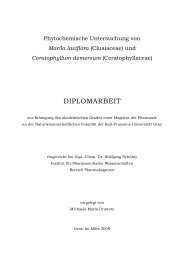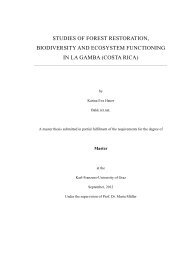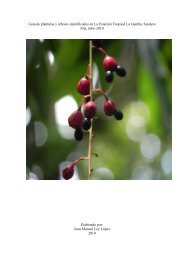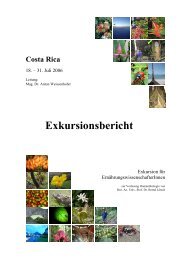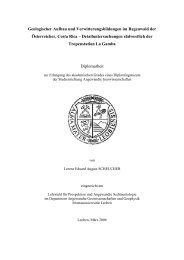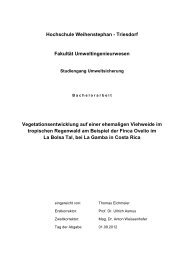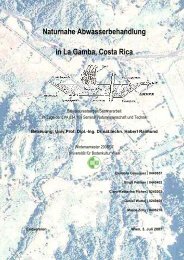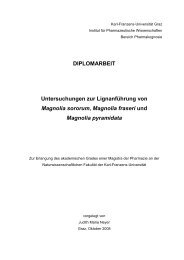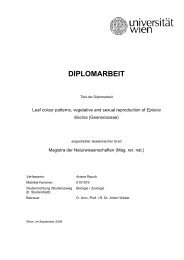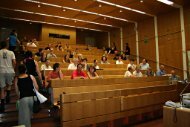Die Tropenstation La Gamba
Die Tropenstation La Gamba
Die Tropenstation La Gamba
Erfolgreiche ePaper selbst erstellen
Machen Sie aus Ihren PDF Publikationen ein blätterbares Flipbook mit unserer einzigartigen Google optimierten e-Paper Software.
<strong>Die</strong> „<strong>Tropenstation</strong> <strong>La</strong> <strong>Gamba</strong>“ in Costa Rica – Wissenschaftlicher Bericht<br />
Non-indigenous plants in a tropical lowland region in Costa Rica<br />
Huber W, Weissenhofer A, Mayer V, Schaber D, Schembera E,<br />
University of Vienna, Department of Palynology and Structural Botany, Austria<br />
4 th European Conference on Biological Invasions, Vienna, 27. – 29. Sept. 2006<br />
We report an investigation of vascular plants in a wet tropical lowland region of southern<br />
Costa Rica (near the <strong>Tropenstation</strong> <strong>La</strong> <strong>Gamba</strong> – www.lagamba.at). We recorded<br />
vegetation composition in 18 different habitats, using vegetation plots with sizes ranging<br />
from 2.25 to 1,500 m 2 . A total of 770 species of vascular plants were found. Of these, 25<br />
(3.2%) were non-indigenous.<br />
The habitats investigated ranged from primary forest to cultivated land. The average<br />
annual precipitation of 5,690 mm, the annual mean temperature of nearly 28°C and the<br />
absence of a pronounced dry season (Weber et al. 2001) have resulted in the establishment<br />
of a “perhumid tropical lowland wet forest”. During the time of cultivation and increasing<br />
land use, especially since the beginning of the 20 th century when the United Fruit<br />
Company began to clear forest, largely for banana cultivation, plants from other tropical<br />
regions have been introduced into the area around the Golfo Dulce. Agricultural land with<br />
plantations of trees, manioc or rice and pasture is now common and primary forest is<br />
largely restricted to the national parks (Corcovado and Piedras Blancas).<br />
No exotic plant species were counted in the primary research plots on the ridge, in the<br />
clearing with the dominant fern Dicranopteris, on the rock in the surge and in the steep<br />
coastal forest of the Golfo Dulce. In the plots of cultivated land (plantations) more nonindigenous<br />
plants were found. Six species were counted in the teak (Tectona grandis)<br />
plantation and four in the Gmelina arborea plantation. In the pasture land, swampy<br />
pasture land and pasture edges we found a total of seven non-indigenous plants. On the<br />
two coastal research plots, three non-indigenous plants were identified. In two natural<br />
habitats on the coast of the Golfo Dulce the non-indigenous Cocos nucifera and<br />
Terminalia catappa are the dominant arboreal species.<br />
The alien fern Nephrolepis multiflora is dominant in wet, open areas outside the forest. In<br />
total there are more non-indigenous plants outside the primary forest, especially in pasture<br />
land and cultivations. The invasion of alien plants in the tropical lowlands of south-west<br />
Costa Rica is not as pronounced as in the country's highlands (Bernhard & Koch 1994).<br />
The non-indigenous vascular plants we identified are Allamanda cathartica<br />
(Apocynaceae), Arachis pintoi (Fabaceae), Cocos nucifera (Arecaceae), Citrus<br />
aurantifolia (Rutaceae), Terminalia catapa (Combretaceae), Costus speciosus<br />
(Costaceae), Desmodium adscendens( Fabaceae), Eichhornia crassipes (Pontederiaceae),<br />
Elaeis guineensis (Arecaceae), Emilia fosbergii (Asteraceae), Ficus benjamina<br />
(Moraceae), Gmelina arborea (Verbenaceae), Hedychium coronarium (Zingiberaceae),<br />
Kyllinga odorata (Cyperaceae), <strong>La</strong>gerstroemia speciosa (Lythraceae), Ludwigia<br />
hyssopifolia (Onagraceae), Ludwigia octovalvis (Onagraceae), Mimosa pudica<br />
(Mimosaceae), Nephrolepis multiflora (fern, Oleandraceae), Quararibea cordata<br />
(Malvaceae/Bomb.), Senna alata (Caesalpiniaceae), Syzygium jambos (Myrtaceae) and<br />
Tectona grandis (Verbenaceae).<br />
Literature:<br />
Bernhard KG & Koch M. (1994): Eingeführte Pflanzen aus Europa als Bestandteil der<br />
Vegetation Costa Ricas (Zentralamerika). – Bauhinia 11/2: pp. 121-127.<br />
Weber A., Huber W., Weissenhofer A., Zamora N., Zimmermann G. (2001): An<br />
introductory Field Guide to the Flowering Plants of the Golfo Dulce Rainforests -<br />
Corcovado Nationalpark and Piedras Blancas Nationalpark ("Regenwald der<br />
Österreicher"). – Linz: OÖ <strong>La</strong>ndesmuseum Stapfia 78: pp. 462.<br />
74



